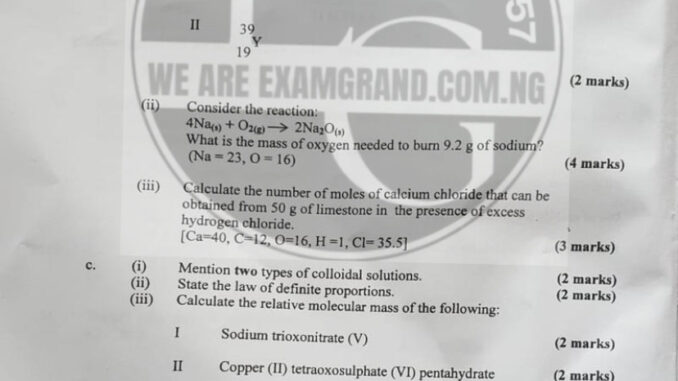
SUBJECT: NECO 2023 JUNE/JULY CHEMISTRY (OBJ & ESSAY) QUESTIONS AND ANSWERS -EXPO AND THE PIN IS “780
“
REFRESH PAGE==>
NECO 2023 JUNE/JULY CHEMISTRY (OBJ & ESSAY) QUESTIONS AND ANSWERS -EXPO
Examgrand.Com.Ng
Examgrand.Com.Ng
°°°°°°°°°°°°°°°°°°°°°°°°°°°°°°°°°°°°°°°°°°°°°°°°
CLICK HERE TO JOIN OUR TELEGRAM CHANNEL FOR ALL 2023 EXAM ANSWERS FOR FREE
°°°°°°°°°°°°°°°°°°°°°°°°°°°°°°°°°°°°°°°°°°°°°°°°
NOTICE!!!!!!!!!Always check back this page And Scroll down for All the Question & Answers & Don’t just come in and leave
========================================
NECO 2023 CHEMISTRY QUESTIONS;-ExamgrandComNg !!!!!




=======================================
NECO CHEMISTRY OBJ;-ExamgrandComNg
1-10: DEADADECAD
11-20: BAEDDBDBAE
21-30: CCDCABDDCD
31-40: EBEECEBCEE
41-50: BCCECDDADD
51-60: DABBDEAECA
Completed.
=========================================
QUESTION CHEMISTRY (1)
(1ai)
(i) Manufacturing sulfuric acid
(ii) Vulcanization of rubber
(iii) Formulation of Pesticides and fungicides
(1aii)
(i) It is a colorless gas that has a distinct smell of rotten eggs
(ii) Hydrogen sulphide is soluble in water to some extent
(1aiii)
Soaps are made from natural products while detergents are made from synthetic products.
(1aiv)
Detergents is for household cleaning and laundry purposes
(1bi)
Number of neutrons = Mass number (A) – Atomic number (Z)
I. ²³₁₁X
A = 23 (mass number)
Z = 11 (atomic number)
Number of neutrons = 23 – 11 = 12
II. ³⁹₁₉Y
A = 39 (mass number)
Z = 19 (atomic number)
Number of neutrons = 39 – 19 = 20
(1bii)
Molar mass:
Na = 22.99 g/mol
O₂ = 2 * 16.00 g/mol = 32.00 g/mol
Now, let’s calculate the mass of oxygen needed:
First, calculate the number of moles of sodium (Na) in 9.2g:
Number of moles = Mass / Molar mass
Number of moles of Na = 9.2g / 22.99 g/mol ≈ 0.4002 mol
Since the mole ratio of Na to O₂ is 4:1, the number of moles of O₂ needed is:
Number of moles of O₂ = 0.4002 mol / 4 ≈ 0.1001 mol
Now, calculate the mass of oxygen needed:
Mass of O₂ = Number of moles of O₂ * Molar mass of O₂
Mass of O₂ = 0.1001 mol * 32.00 g/mol ≈ 3.204 g
Therefore, approximately 3.204 grams of oxygen are needed to burn 9.2 grams of sodium.
(1biii)
CaCO₃(s) + 2 HCl(aq) —> CaCl₂(aq) + CO₂(g) + H₂O(l)
From the balanced equation, 1 mole of calcium carbonate (CaCO₃) reacts with 2 moles of HCl to produce 1 mole of calcium chloride (CaCl₂).
Molar masses:
CaCO₃ = Ca(40.08) + C(12.01) + 3O(16.00) = 100.09 g/mol
CaCl₂ = Ca(40.08) + 2Cl(35.45) = 110.98 g/mol
Now, let’s calculate the number of moles of CaCO₃ in 50g:
Number of moles of CaCO₃ = Mass / Molar mass
Number of moles of CaCO₃ = 50g / 100.09 g/mol ≈ 0.4998 mol
Since the mole ratio of CaCO₃ to CaCl₂ is 1:1, the number of moles of CaCl₂ that can be obtained is also approximately 0.4998 mol.
Thus, about 0.4998 moles of calcium chloride can be obtained from 50g of limestone in the presence of excess hydrogen chloride.
(1ci)
(i) Sol: A sol is a colloidal solution in which solid particles are dispersed in a liquid medium.
(ii) Aerosol: An aerosol is a colloidal solution in which liquid or solid particles are dispersed in a gas medium.
(1cii)
The law of definite proportions, also known as the law of constant composition, states that a given chemical compound always contains its constituent elements in fixed and definite proportions by mass. This means that the ratio of the masses of the elements in a compound is constant, regardless of the compound’s origin or method of preparation.
(1ciii)
(I) Sodium trioxonitrate (V) is also known as sodium nitrate, with the chemical formula NaNO₃.
The atomic masses are as follows:
Na (Sodium) = 22.99 g/mol
N (Nitrogen) = 14.01 g/mol
O (Oxygen) = 16.00 g/mol
Relative molecular mass of NaNO₃ = (1 * Na) + (1 * N) + (3 * O)
Relative molecular mass of NaNO₃ = (1 * 22.99 g/mol) + (1 * 14.01 g/mol) + (3 * 16.00 g/mol)
Relative molecular mass of NaNO₃ = 22.99 g/mol + 14.01 g/mol + 48.00 g/mol
Relative molecular mass of NaNO₃ = 85.00 g/mol
Therefore, the relative molecular mass of sodium nitrate (NaNO₃) is 85.00 g/mol.
(II) Copper (II) trioxosulphate (VI) pentahydrate is also known as copper (II) sulfate pentahydrate, with the chemical formula CuSO₄ · 5H₂O.
The atomic masses are as follows:
Cu (Copper) = 63.55 g/mol
S (Sulfur) = 32.06 g/mol
O (Oxygen) = 16.00 g/mol
H (Hydrogen) = 1.01 g/mol
Relative molecular mass of CuSO₄ · 5H₂O = (1 * Cu) + (1 * S) + (4 * O) + (10 * H) + (5 * O)
Relative molecular mass of CuSO₄ · 5H₂O = (1 * 63.55 g/mol) + (1 * 32.06 g/mol) + (4 * 16.00 g/mol) + (10 * 1.01 g/mol) + (5 * 16.00 g/mol)
Relative molecular mass of CuSO₄ · 5H₂O = 63.55 g/mol + 32.06 g/mol + 64.00 g/mol + 10.10 g/mol + 80.00 g/mol
Relative molecular mass of CuSO₄ · 5H₂O = 249.71 g/mol
Therefore, the relative molecular mass of copper (II) sulfate pentahydrate (CuSO₄ · 5H₂O) is 249.71 g/mol.
=========================================
QUESTION CHEMISTRY (2)
(2ai)
Mass of silver deposited (in grams) = (Current in Amperes × Time in seconds × Atomic mass of silver) / (1 Faraday)
Given:
Current = 4.6 A
Time = 90 minutes = 90 × 60 seconds = 5400 seconds
Atomic mass of silver (Ag) = 108g/mol
1 Faraday = 96,500C
Substituting the values to calculate the mass of silver deposited:
Mass of silver deposited = (4.6 A × 5400 s × 108 g/mol) / 96,500 C
Mass of silver deposited ≈ (2,682,720 g·s/mol) / 96,500 C
Mass of silver deposited ≈ 27.8g
(2aii)
(i) Electrode surface area
(ii) Electrolyte temperature
(2aiii)
(i) The oxidizing agent is MnO₄⁻(aq)
(ii) The reducing agent is Fe²⁺(aq)
(2aiv)
MnO₄⁻(aq) + 8H⁺(aq) + 5e⁻ —-> Mn²⁺ + 4H₂O(l)
(2bi)

(2bii)
(i) Gases have no fixed shape or volume.
(ii) Gases have low density compared to solids and liquids.
(iii) Gases have high kinetic energy and are in constant motion.
(2biii)
Faraday’s second law of electrolysis states that the mass of a substance deposited (or liberated) during electrolysis is directly proportional to the quantity of electric charge passed through the electrolyte.
(2biv)
(i) Charcoal
(ii) Coal
(2bv)
Na (Sodium) > Ca (Calcium) > Mg (Magnesium) > Al (Aluminum)
=====================================================
QUESTION CHEMISTRY (3)
(3ai)
(i) Butan-2-ol – Secondary alkanol
(ii) 2-methylpropanol – Primary alkanol
(iii) 2-methylpropan-2-ol – Tertiary alkanol
(3aii)
(i) Fermentation
(ii) Ethylene hydration
(3aiii)
Let the relative molecular mass of gas Z be M.
(Rate of diffusion of hydrogen)/(Rate of diffusion of gas Z) = √(molar mass of gas Z)/√(molar mass of hydrogen)
6/1 = (√M)/(√2)
36 = M/2
M = 2×36
M = 72
(3bi)
1s², 2s², 2p⁴
(3bii)
(i) It is a colorless
(ii) It is soluble in water.
(iii) It is tasteless
(3biii)
(i) Identify the longest chain.
(ii) Name the substituents alphabetically
(3biv)
C₂H₄ + O₂ —> 2CO₂ + 2H₂O
(3ci)
Endothermic reaction can be defined as a form of heat reaction in which heat is absorbed from the surrounding into the reacting system.
(3cii)
Zn(s) + H₂SO₄(aq) —> ZnSO₄(aq) + H₂(g)
(3ciii)
Redox reaction.
(3iv)
(i) For refining petrol
(ii) For food processing
(iii) For producing fertilizer
=====================================================
QUESTION CHEMISTRY (4)
(4ai)
A super saturated solution is a solution that contains more than the maximum amount of solute that is capable of being dissolved at a given temperature.
(4aii)
15/345 = Solubility *25/1000
Solubility =1000*15/25*345=15000/8625
Solubility = 1.79mol/dm³
(4aiii)
(i) H₃0⁺
(ii) NH₄⁺
(iii) [CN]⁻₆
(4bi)
(i) It has no chemical formula
(ii) It can be separated physically
(iii) Freezing air slowly yields different liquids at different temperatures
(4bii)
(i) Noble gases
(ii) Carbon (iv) oxide
(4biii)
H₂SO₄ —-> 2H+ + SO₄²⁻
1 mole of H₂SO₄ = 2 mole of H⁺
0.1 mole of H₂SO₄ = 0.2 mole of H⁺
Mole = no. of H⁺/Avogadro’s constant
No. of H⁺ = Mole * Avogadro’s constant
= 0.2 * 6.0*10²³
= 1.2*10²³ ions
(4biv)
(i) Dative bonding
(ii) Hydrogen bonding
(4bv)
(i) BRASS:
Constituent: Copper and zinc.
Use: Brass is used in the production of musical instruments decorative items and plumbing fixtures.
(ii) BRONZE:
Constituent: Copper and tin.
Use: Bronze is used in the production of statues coins and various machinery.
=====================================================
QUESTION CHEMISTRY (5)
(5ai)
A base is a substance which when disolve produce hydroxyl ion (OH⁻) as the only negative ion
(5aii)
(i) K₂O
(ii) MgO
(5aiii)
(i) it is used in printing inks and dyes
(ii) it is used in making photographic chemicals
(5aiv)
Aliphatic does not have good odour while an aromatic hydrocarbon has
(5av)
M.m of XCl₃=10-8+(35-5*3)
=10.8+106.5
=117.3
Vapour density =117.3/2=58.65
(5bi)
(i) Temperature
(ii) concentration
(iii) surface area
(5bii)
The law states that energy can neither be created nor destroyed in and isolated system.
(5biii)
(i) burning of wood
(ii) neutralization reaction
5C
.jpeg)
=====================================================
QUESTION CHEMISTRY (6)
.jpeg)
=====================================================
Completed.!!!!!





Satisfied